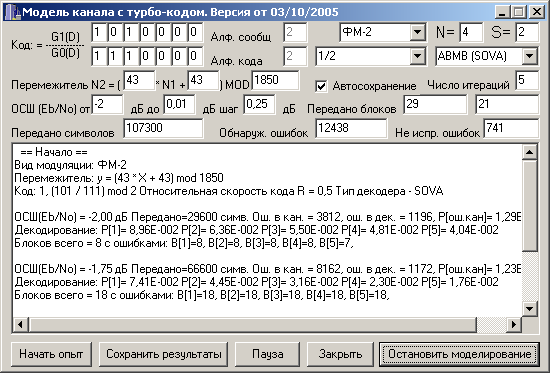
- •3 Laboratory works Laboratory work 1 Cyclic code codecs construction principles research
- •Laboratory work 2 Cyclic codes correcting capability research
- •Laboratory work 3 Error correction principle of convolutional code with the threshold decoding algorithm
- •Laboratory work 4 Systematic convolutional codes correcting capability research
- •Laboratory work 5 Nonsystematic convolutional codes correcting capability research
- •Laboratory work 6 Digital communication system with a concatenated coding research
- •Laboratory work 7 Turbo-codes with iterative soft-decision Viterbi decoding algorithm corrective capability research
Laboratory work 7 Turbo-codes with iterative soft-decision Viterbi decoding algorithm corrective capability research
Objective: To study the rules of construction turbo codes coders and decoders based on the component recursive systematic convolutional codes (RSC). To research the characteristics of turbo codes corrective capability.
Laboratory emulator:
After running the program “Turbo.exe” you can see interface like fig. 3.9.

Figure 3.9 – Interface of laboratory work
Text cells “G1(D)/G0(D)”, “Eb/No”, are filled according to the number of brigade from the table 3.11. It is need to transform polynomials G1(D)/G0(D) from octal to binary form and enter in order from right to left. Relative information transfer rate is chosen from the list. Another data it is need to left without changes.
In the result of the experiment, you get next parameters:
Eb/No – signal noise ratio;
Передано – amount of bits, transferred through the channel
Ош. в кан. – amount of errors at the output of the DSC;
Ош. в дек. – amount of errors at the output of the decoder;
Р[ош.кан] – errors coefficient at the output of the DSC;
Р[i] – errors coefficient at the output of the decoder after i iterations;
B[i] – amount of blocks with errors after i iterations.
Laboratory task:
To run the program Turbo.exe.
To enter the initial data from the table 3.11.
Table 3.11 – Initial data for laboratory work
Number of brigade |
RSC |
R2 |
Eb/No |
1 |
1, 5/7 |
1/3 |
-4…-2 дБ =0,25 дБ |
2 |
1, 17/15 |
1/3 |
-4…-2 дБ =0,25 дБ |
3 |
1, 35/23 |
1/3 |
-4…-2 дБ =0,25 дБ |
4 |
1, 5/7 |
1/2 |
-2…0 дБ =0,25 дБ |
5 |
1, 17/15 |
1/2 |
-2…0 дБ =0,25 дБ |
6 |
1, 35/23 |
1/2 |
-2…0 дБ =0,25 дБ |
7 |
1, 5/7 |
2/3 |
0…2 дБ =0,25 дБ |
8 |
1, 17/15 |
2/3 |
0…2 дБ =0,25 дБ |
To fill the table 3.12.
Table 3.12 – Results of the laboratory experiment
Eb/No [дБ] |
Р[ош.кан] |
Р[1] |
Р[2] |
Р[3] |
Р[5] |
|
|
|
|
|
|
|
|
|
|
|
|
|
|
|
|
|
|
|
|
|
|
|
|
|
|
|
|
|
|
|
|
|
|
|
|
|
|
|
|
|
|
|
|
|
|
|
|
|
|
|
|
|
|
Using table 3.12, to build the diagrams Р[ош.кан] = f (Eb/No) and Р[i] = f (Eb/No), using Application C.
Home task:
To learn items 1.3.3, 1.4.3 – 1.4.4 of this teaching manual.
To write down the answers to the general questions.
To prepare the table 3.12 in the protocol.
To prepare blank using Application C.
General questions:
Which classes do turbo codes belong to?
What are recursive systematic convolutional codes?
Describe the principle of the parallel concatenated coding.
Why don’t unrecursive codes in turbo codes use?
Describe the decoding algorithms of turbo codes.
Describe the soft output Viterbi algorithm.
Describe the principle of iterative decoding.
Protocol content:
Subject and objective.
Executed home task.
Graph and table according to laboratory task.
Conclusion. Compare two characteristics Р[1] = f (Eb/No) and Р[5] = f (Eb/No).
